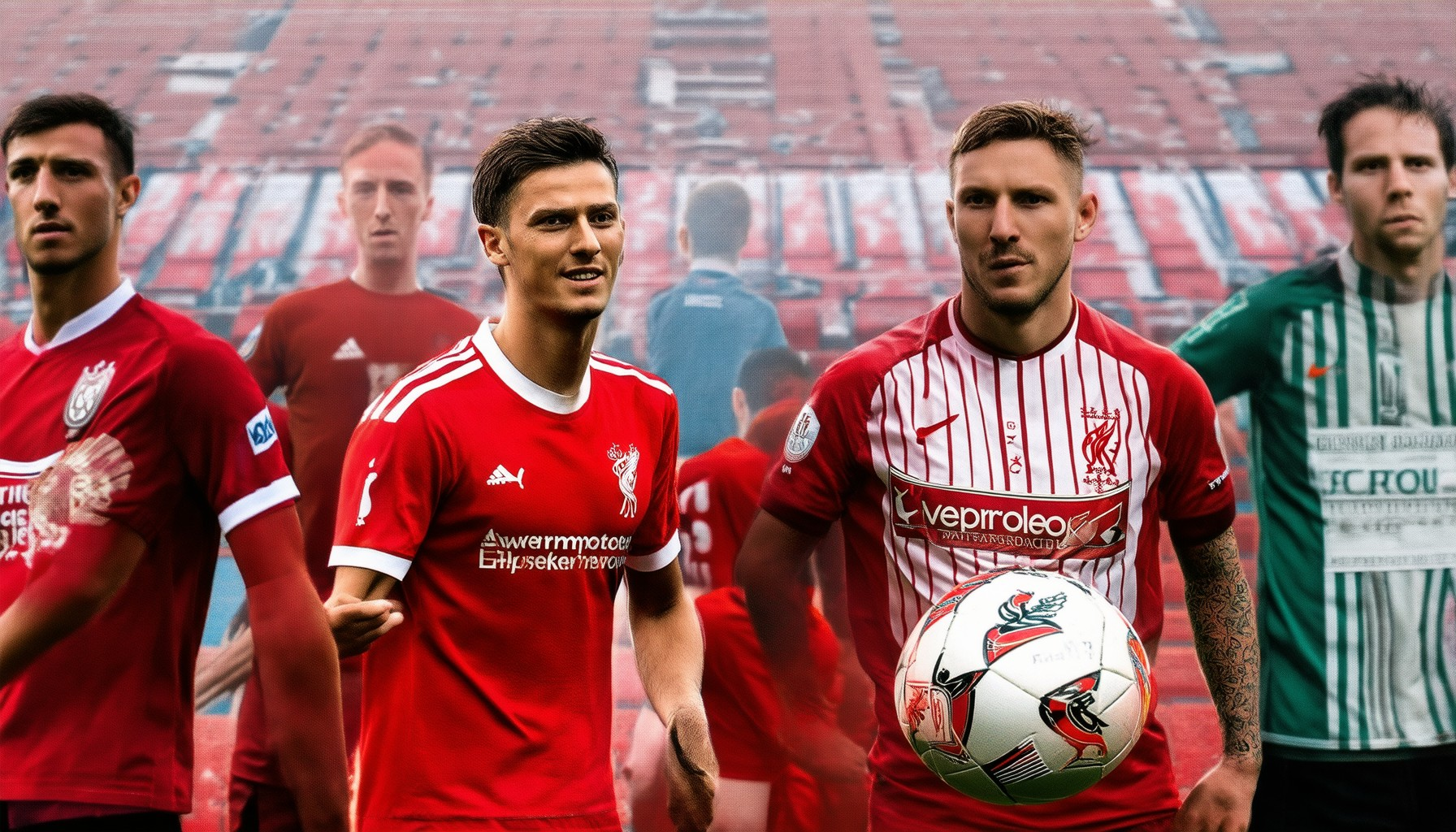Exploring Liverpool FC’s Transfer Masterclass: A Deep Dive Into Their Strategic Moves
Liverpool FC’s transfer strategy has long been a subject of fascination for football enthusiasts and analysts alike. With each new signing and departure, fans and experts alike wonder what lies behind the club’s decision-making process. This article delves into the intricate world of LFC transfer news insights, offering a comprehensive analysis of the strategies, patterns, and key players shaping the Reds’ squad. From the role of data analytics to the influence of managerial vision, we’ll uncover the secrets behind Liverpool’s transfer triumphs and the lessons learned from past successes and controversies. Join us as we explore how Liverpool’s transfer news updates reveal the club’s recruitment philosophy and its impact on team performance. Whether you’re a die-hard supporter or a casual observer, this article promises fresh perspectives on one of football’s most dynamic teams.
Key Takeaways
– Sophisticated Recruitment: Liverpool FC employs a meticulous process to sign players aligned with their style and long-term vision, often securing top talent early, such as Virgil van Dijk and Alisson Becker, emphasizing quality and longevity.
– Outstanding Player Development: Renowned for their exceptional pathway, Liverpool transforms raw talent into world-class players, exemplified by Trent Alexander-Arnold’s rise from youth prospect to first-team star.
– Financial Acumen: Balancing ambition with prudence, Liverpool manages transfers efficiently, setting a benchmark for financial management during economic challenges.
– Competitor Analysis: The club strategically counters rival signings, like those of Manchester United and Chelsea, to maintain market leadership and stay ahead in the transfer race.
– Conclusion: Balanced Strategy: Liverpool’s approach blends investing in youth for future success with experienced signings for immediate competitiveness, ensuring sustained dominance in English football.
This section encapsulates Liverpool FC’s strategic approach to transfers, highlighting their commitment to quality, development, and long-term success.

What Expert Insights Reveal About Liverpool FC’s Transfer Strategies
Liverpool FC’s transfer strategies have been a subject of intense scrutiny, with experts analyzing their approach to player recruitment, development, and overall team composition. Here’s a breakdown of the key insights:
Recruitment Process
The Reds have developed a sophisticated recruitment process that prioritizes signing players who align with their playing style and long-term vision. Their scouting network is renowned for identifying talent early, often snapping up players before major rivals. For instance, the club’s ability to secure young stars like Virgil van Dijk and Alisson Becker has been instrumental in their recent success. These signings demonstrate a strategic focus on quality and longevity rather than short-term fixes.
Player Development Pathway
Liverpool’s player development pathway is widely regarded as one of the best in football. From their academy to senior teams, the club invests heavily in nurturing young talents. The presence of Jurgen Klopp has further enhanced their ability to transform raw talent into world-class players. For example, the progression of Trent Alexander-Arnold from a youth prospect to a first-team regular highlights their commitment to player growth and integration.
Financial Planning and Strategy
Financial acumen plays a crucial role in Liverpool’s transfer strategy. The club consistently balances ambition with financial prudence, ensuring they can compete with the likes of Manchester United and Chelsea without overextending their budget. Their ability to manage transfers during uncertain economic times has been a model for others to follow. The club’s ownership has shown a willingness to invest in the right players, even during periods of financial constraint.
Competitor Analysis
Understanding competitors is a key part of Liverpool’s strategy. While they don’t openly praise rivals, their actions speak louder. For example, their signings often counter those of Manchester United and Chelsea, indicating a focus on staying ahead in the market. Liverpool’s ability to identify gaps in opposition teams has been a driving force behind their transfer decisions.
For more detailed insights into Liverpool FC’s transfer strategies, explore their comprehensive guide on The Anfield Talk, where we dive deeper into recruitment processes and player development systems.
Looking ahead, Liverpool’s transfer strategy continues to evolve, blending tradition with innovation. By focusing on quality, character, and long-term sustainability, the club aims to remain a dominant force in European football.
What Do LFC Transfer Insights Reveal About the Club’s Strategy?
Liverpool FC’s transfer strategy has always been centered around building a competitive squad capable of challenging for titles. Recent moves highlight a blend of youth development and experienced signings.
- Investment in Youth: The club continues to prioritize nurturing young talent, as seen with signings like Jude Bellingall and Harvey Barnes, who joined for significant fees. This reflects a long-term vision focused on developing homegrown stars.
- Targeting Key Positions: Transfers often aim to strengthen defensive and attacking departments. For instance, the arrival of Virgil van Dijk and Alisson Becker has bolstered defense, while players like Sadio Mane and Mohamed Salah enhance attacking options.
- Strategic Midfield Signings: Midfield investments like Fabinho and Dominik Szoboszlai aim to balance creativity and work rate, crucial for high-intensity games. This mirrors the club’s preference for versatile midfielders.
- Global Recruitment Network: Liverpool’s scouting network remains extensive, sourcing talent from various leagues. This global approach ensures access to the best available players, regardless of their league origin.
The club’s strategy is further evident in its willingness to spend big on star signings, reflecting an ambition to stay at the top of European football. This approach aligns with historical successes and maintains pressure on rivals like Manchester City and Chelsea .
Overall, Liverpool’s transfer policy underscores a commitment to sustained success through smart recruitment and a clear vision of the type of players needed to achieve their goals.

Key Insights From LFC Transfer Updates On Recruitment Strategy
The Liverpool Football Club’s transfer updates offer valuable insights into their recruitment strategy, highlighting their approach to building a competitive squad. Here’s a breakdown of the key takeaways:
- Targeted Positions:** LFC has shown a preference for specific positions during recent transfers. Midfielders and defensive players have been priority targets, reflecting their emphasis on stability and control in high-pressure games.
- Nationwide Signings:** The club has diversified their recruitment by signing players from various countries, including England, Brazil, and Spain. This strategy aims to bring in versatile talent with global perspectives.
- Focus on Youth Development:** While acquiring established stars, LFC has also invested in young talents from their academy. This indicates a long-term vision to build a sustainable team through homegrown talent and experienced signings.
- Competitor Analysis:** By monitoring competitors like Manchester United and Chelsea, LFC adapts their strategy to stay ahead. Their transfers often counteract rival moves, showcasing a proactive approach to the market.
- Data-Driven Decisions:** The club’s recruitment team uses advanced analytics to identify undervalued players and optimize their signings. This data-centric approach ensures they target players who can immediately impact the team.
LFC’s recruitment strategy is balanced between immediate needs and future planning, ensuring the squad remains competitive while nurturing young talent. This approach has been instrumental in their recent success on the pitch.

What Expert Insights Reveal About Liverpool FC’s Transfer Strategies
Liverpool FC’s transfer strategies have been a subject of intense scrutiny, with experts analyzing their approach to player recruitment, development, and overall team composition. Here’s a breakdown of the key insights:
Recruitment Process
The Reds have developed a sophisticated recruitment process that prioritizes signing players who align with their playing style and long-term vision. Their scouting network is renowned for identifying talent early, often snapping up players before major rivals. For instance, the club’s ability to secure young stars like Virgil van Dijk and Alisson Becker has been instrumental in their recent success. These signings demonstrate a strategic focus on quality and longevity rather than short-term fixes.
Player Development Pathway
Liverpool’s player development pathway is widely regarded as one of the best in football. From their academy to senior teams, the club invests heavily in nurturing young talents. The presence of Jurgen Klopp has further enhanced their ability to transform raw talent into world-class players. For example, the progression of Trent Alexander-Arnold from a youth prospect to a first-team regular highlights their commitment to player growth and integration.
Financial Planning and Strategy
Financial acumen plays a crucial role in Liverpool’s transfer strategy. The club consistently balances ambition with financial prudence, ensuring they can compete with the likes of Manchester United and Chelsea without overextending their budget. Their ability to manage transfers during uncertain economic times has been a model for others to follow. The club’s ownership has shown a willingness to invest in the right players, even during periods of financial constraint.
Competitor Analysis
Understanding competitors is a key part of Liverpool’s strategy. While they don’t openly praise rivals, their actions speak louder. For example, their signings often counter those of Manchester United and Chelsea, indicating a focus on staying ahead in the market. Liverpool’s ability to identify gaps in opposition teams has been a driving force behind their transfer decisions.
For more detailed insights into Liverpool FC’s transfer strategies, explore their comprehensive guide on The Anfield Talk, where we dive deeper into recruitment processes and player development systems.
Looking ahead, Liverpool’s transfer strategy continues to evolve, blending tradition with innovation. By focusing on quality, character, and long-term sustainability, the club aims to remain a dominant force in European football.
What Expert Insights Reveal About Liverpool FC’s Transfer Strategies
Liverpool FC’s transfer strategies have been a subject of intense scrutiny, with experts analyzing their approach to player recruitment, development, and overall team composition. Here’s a breakdown of the key insights:
Recruitment Process
The Reds have developed a sophisticated recruitment process that prioritizes signing players who align with their playing style and long-term vision. Their scouting network is renowned for identifying talent early, often snapping up players before major rivals. For instance, the club’s ability to secure young stars like Virgil van Dijk and Alisson Becker has been instrumental in their recent success. These signings demonstrate a strategic focus on quality and longevity rather than short-term fixes.
Player Development Pathway
Liverpool’s player development pathway is widely regarded as one of the best in football. From their academy to senior teams, the club invests heavily in nurturing young talents. The presence of Jurgen Klopp has further enhanced their ability to transform raw talent into world-class players. For example, the progression of Trent Alexander-Arnold from a youth prospect to a first-team regular highlights their commitment to player growth and integration.
Financial Planning and Strategy
Financial acumen plays a crucial role in Liverpool’s transfer strategy. The club consistently balances ambition with financial prudence, ensuring they can compete with the likes of Manchester United and Chelsea without overextending their budget. Their ability to manage transfers during uncertain economic times has been a model for others to follow. The club’s ownership has shown a willingness to invest in the right players, even during periods of financial constraint.
Competitor Analysis
Understanding competitors is a key part of Liverpool’s strategy. While they don’t openly praise rivals, their actions speak louder. For example, their signings often counter those of Manchester United and Chelsea, indicating a focus on staying ahead in the market. Liverpool’s ability to identify gaps in opposition teams has been a driving force behind their transfer decisions.
For more detailed insights into Liverpool FC’s transfer strategies, explore their comprehensive guide on The Anfield Talk, where we dive deeper into recruitment processes and player development systems.
Looking ahead, Liverpool’s transfer strategy continues to evolve, blending tradition with innovation. By focusing on quality, character, and long-term sustainability, the club aims to remain a dominant force in European football.

What Do LFC Transfer Insights Reveal About the Club’s Strategy and Player Choices?
The Liverpool FC transfer strategy has always been a subject of intense scrutiny, offering valuable insights into the club’s approach to building a competitive squad. Recent transfer activity underscores a blend of youth development and experienced signings, reflecting a balanced strategy aimed at both the present and future success.
Focus on Young Talent
Liverpool’s transfer policy has increasingly prioritized the acquisition of young, promising players who can grow into the club’s first-team fold. Players like Jude Bellingall, Harvey Barnes, and Rhys Williams have been snapped up, showcasing the club’s commitment to nurturing homegrown talent. This strategy aligns with the broader trend of investing in youth to sustain long-term success.
Midfield Reinforcements
Recent signings such as Dominik Szoboszlai and Alex Oxlade-Chamberlain demonstrate Liverpool’s intent to bolster their midfield options. These additions aim to provide depth and versatility, crucial for competing at the highest level. The club’s preference for versatile midfielders reflects their desire to adapt to different formations and playing styles, ensuring flexibility on the pitch.
Strategic Philosophy
Liverpool’s transfer decisions are guided by a clear philosophical approach: signing players who can thrive in an high-pressing, attacking style of play. Players like Darwin Núñez and Luis Díaz were specifically chosen for their ability to fit seamlessly into this system, offering both goalscoring prowess and positional interchangeability.
Competitive Context
While Liverpool’s transfers are internally driven, external factors such as the strength of competitors like Chelsea and Manchester City influence the club’s priorities. Liverpool’s signings often aim to counteract the threat posed by these rivals, ensuring the squad remains capable of challenging for titles and trophies.
A Conclusion on Liverpool’s Strategy
Overall, Liverpool’s transfer strategy reflects a thoughtful approach: investing in youth to build for the future while adding experienced players to maintain immediate competitiveness. This dual focus ensures the club remains a force in English football, blending continuity with evolution in their quest for sustained success.





0 Comments